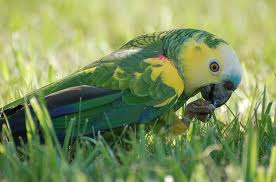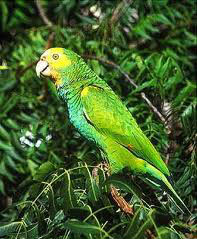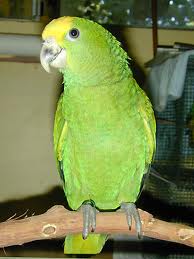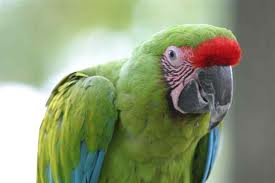
PARROT RESCUE
AMAZON PARROT
The Amazon Parrot, one of the most popular pet parrots

-
The Amazon is a loving and sociable parrot originating from South America.
The affectionate and loyal nature of the Amazon make this bird a wonderful pet for those experienced with companion parrots. Amazons are highly intelligent and require a devoted owner who is willing to provide significant and meaningful attention, as well as stimulus such as chewing toys to keep them happy and healthy.
Hand reared male birds from aviary bred parents make the best pets. Amazons are generally easily trained and have an excellent talking ability. If not provided with the necessary training and socialisation, the Amazon can become aggressive and susceptible to other behavioural problems.
| HOME |
|---|
| SPECIES |
| REHOMING |
| LOST |
| FOUND |
| LINKS |
| FOR SALE |
| EMERGENCY |
| HELP |


DIET & NUTRITION
A variety of food is essential for providing the best possible care for your parrot.
A pellet based diet is the best thing for your parrot but this must be supplimented with foods like:
Carrots, Broccoli (calcium),Peppers, Celery, Cucumbers and Leaf lettuce (not iceburg)
Melons, Kiwi, Grapes, Oranges and Berries
No No Foods
Alcohol, Coffee and Caffein, Chocolate, Avocado, Mushrooms, Onions, Rhubarb and High Fat foods
Vitamin A deficiency is common in birds whose main diet consists of seeds. Vitamin A promotes appetite, digestion, and also increases resistance to infection and to some parasites.
HEALTH AND BEHAVOIR
|
CAGE
An Amazon parrots cage best suited to adequately house a single Amazon bird would be between 39"- 59" (100-150 cm) high and have a floor space of 23"x 39" (60 x 100 cm). This size will provide room for lots of movement as well as space for perches, food dishes and a variety of playthings.
The basic cage care includes daily cleaning of the water and food dishes. Weekly you should wash all the perches and dirty toys, and the floor should be washed about every other week. A total hosing down and disinfecting of an aviary should be done yearly, replacing anything that needs to be freshened, such as old dishes, toys and perches.
Activities
Exercise and play are important activities for the physical well being and psychological health of your parrot. These activities help deter distress and prevent the problems of screeching and feather picking. Provide your parrot with lots of activities in the form of bird toys such as large link chains, bird ladders, parrot swings, ropes, fresh branches for gnawing and chewing, and rotate new bird toys on a regular basis.
Handling/Training
The Amazon parrot is the most rapid of all the parrots at becoming accustomed to its new environment, its keeper, and ready to start bird training. Generally though, you should give a new arrival a few days to get use to you, your voice and it's cage before trying to handle it. A hand fed baby will not need much taming and can often be handled right away, as it is use to human attention.
- Taming Basics:
Though an Amazon parrot is quick to adapt to its new home, you should give a new arrival a few days to get use to you, your voice and its cage before trying to handle it. A hand fed baby will not need much taming and can often be handled right away, as it is use to human attention.
To be able to handle and train your parrot depends first on trust, so go slowly and be consistent. Amazons are most receptive to bird training in the evening and each session is best if limited to under 20 minutes with about an hour rest in between.
Remember that bird taming and bird training takes patience, never 'punish' you parrot! This only serves to destroy the trust you've spent so much time building. - Initial Training:
Your first goal in bird training is to get the parrot to accept a treat from you, which will lead to it allowing you to gently scratch its head. Then you can begin to work on getting your parrot to step up on your hand. Depending on the tameness of the bird, these two steps can be instantaneous as in a hand fed baby or take several weeks or longer for an untamed bird.
- Advanced Training:
Once your Amazon parrot has gotten over its shyness, then you can work on speech training. Repetition and frequency are the keys here to get your Amazon parrot talking. Almost every Amazon parrot can learn at least a few words, although unlike the African Grey, the Amazon's mimicry sounds rather 'parrot-like'.
The most obvious sign of a vitamin A deficiency is a feather stain above the cere. The staining of the feathers above the nostrils reflects a discharge from the nostrils. Subtle differences may be seen as far as the color intensity of the cere and feathers is concerned - and the overall condition of the plumage. A bird deficient in this vitamin may have pale, rough-looking feathers that lack luster. The cere may look rough instead of smooth, and you may see an accumulation of a yellow dry scale on the sides of the beak.
Vitamin A occurs naturally in dark leafy greens and orange-colored produce, such as apricots, cantaloupes, carrots, red peppers, pumpkins and sweet potatoes. To resolve Vitamin A deficiency, try adding foods like sweet potatoes (either cooked or steamed until soft), mashed up with other fruits will be both loved by your pet bird, as much as it is good for her or him. Many birds also enjoy fresh carrot juice - or try offering shredded carrots. Natural sources are preferable over synthetically produced nutrients, which may not be absorbable and could easily be overdosed).